Felt B12 (2011)
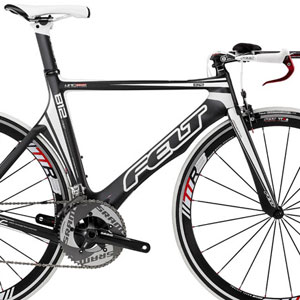
When I was a kid I remember wandering into a dealership showroom and seeing the astoundingly expensive $5,600 price tag on a Chevrolet Corvette. Vettes are now between ten and twenty times that price. Which means they're still astoundingly priced, but, adjusted for inflation.
The bike industry doesn't work like that. Unlike cars, bike models tend to stay pretty similar one year to the next, and they drop in price as the molds get, well, moldier.
So, why did Felt's B12 increase in price from last year to this, by $500, to $3500? Especially since inflation is pretty much at zero, and the frame is a year older?
It's because of how the B12 is spec'd. Last year this was a largely Ultegra bike, now it's SRAM Red (with some variances, so, the spec is not candy apple or fire engine Red, but it's Red where it most counts).
It's Red in the front and rear derailleur, and in the bar-end shifters. The bike also has SRAM Red chainrings. There are some other upgrades as well, and we'll get to that. But the change in gruppo means this bike has been upscaled.
The way Felt has gone about the B12's spec is, well, pure Felt. It's Felt's spec trademark and it's what it does well. If you want "gruppo integrity," buy a Colnago. If you want a company to rip the guts out of a gruppo, dissect it, fish out what's most performance-oriented, and throw the ceramic bearings and teflon coated, graphite embedded, dust covers back into the sea, Felt is that brand.
The crankset in the B12 is a perfect example. You can buy two-and-a-half cranksets spec'd on this B12 for every SRAM Red crank. So, Felt had SRAM put its Red chainrings on this cheaper crank. Let's face it, the chainrings are the business end of a crank, and are most responsible for shifting precision and stiffness. The resulting crank on the B12 is nothing you'll find in a catalog, but, it's raw performance in its conception, and Felt passes the savings on to you.
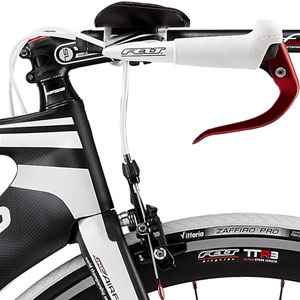
The B12 is therefore spec'd with about the best transmission going for timed racing you'll find on any bike selling for less than $5000. This, if we're talking cabled shift systems (we'll defer the discussion of Di2 for another time). SRAM leads the pack in cabled shifting, largely because of its bar-end shifter. Shimano has conspicuously overlooked this component while SRAM has given it a lot of attention.
The front brake caliper is listed as a "dual pivot" SRAM and I understand the thinking. Back in "the day" I believe I invented the "strategic omission" theory while referencing spec, referring to Shimano "dual pivot" brakes on an otherwise Dura Ace bike. I employed a guy whose job was to remove RX100 from the calipers with a buffing wheel. (Never heard of Shimano RX100? There's a reason why.)
What is the SRAM front brake caliper on the B12? Lord only knows. But it's almost certainly on a par with the "dual pivot" calipers found on Cervelo and many other tri bikes (whenever you simply see "dual pivot" calipers on the spec sheet that's a dead giveaway that "strategic spec referencing" is going on).
Anyway, does the bike stop when you depress the levers? Then shut up.
That established, I think it's time to revisit the idea of aftermarket brake pads and blocks. In my early days of bike racing it was de rigueur to spend oodles on new brakes only to immediately rip off the brake blocks and replace them with Mathausers. Maybe that's something we ought to revisit in triathlon, with all these "dual pivot" brakes stopping fancy schmantzy $2000 carbon-brake-surface race wheelsets. But I digress.
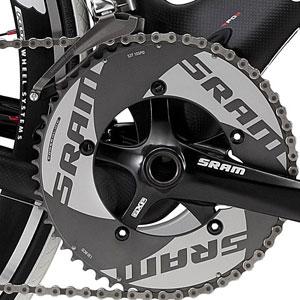
Felt also downspecs the consumables. The B12 comes with a SRAM chain and cassette, but, they're not gold plated. This I agree with. After all, they're consumables. They're meant to be consumed. Consumed and replaced. The silliest thing is to put a SRAM Red cassette on an OEM bike. Why would you put a $250 cassette on a training wheel?
This doesn't mean Felt has gone bargain basement. The B12's cassette is SRAM's OG70. This is SRAM Force level, just below Red. It's probably the cassette I would choose for my race wheels too (I'm not a fan of ti cogs for any level of racing).
The B12 and B14 share the same aerobar spec, and it's the Devox aerobar with an aluminum undercarriage and extensions. Really, the basis for any aerobar is the pursuit bar, armrest and the extension shape. If the ergonomics are unchanged, then, whether the pursuit bar or extension is made of aluminum or carbon is much less important. Felt's armrest, and its F-bend extension, are more than adequate, and don't require a swap-out for an aftermarket product. This version of the Devox is slightly weighty, but is otherwise quite adequate.
Felt has introduced a new non-Bayonet fork into the B12 for this year, replacing last year's non-Bayonet fork. It's a newer, upgraded carbon fork, still one-inch aluminum steerer, and it replaces its 3.2 Carbon Aero Road fork from a year ago. The new fork is actually about 40 grams heavier than last year's fork, but I'm not a fan of ultra lightweight forks anyway. The day your fork breaks is not a good day. This is still a circa-400 gram fork, by no means an anchor, especially for an aero fork.
The B12 sports a set of function-ambiguous OE wheels typical of tri bike makers. Last year's B12 also had these 20/24 bladed-spoked wheels with 40mm deep rims. Why are these spec'd? [soapbox mode on] It's because you, the consumer (and it's the generic "you" I'm writing to) should understand that there are race wheels and then there are training wheels, and when you make training wheels look "racy" the entire bike looks more like what you want on your roof rack. That's the idea behind the racy-looking training wheels all bike companies put on their bikes these days.
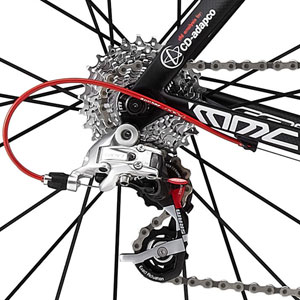
If you understood the concept here, what you'd want ideally on a bike like this—if pure function, not looks, is your aim—are 32/32 round spokes into a box-section rim—a wheelset that will put you to sleep just by looking at it, but, will give you years of dependable service. Then, when you want a set of proper race wheels, by golly, go out and get yourself some.
Not that there is anything wrong with Felt's TTR-3 wheelset that's spec'd on the B12, rather consider Felt's Z5. This great $2000 all-rounder road bike is spec'd with Mavic CXP-22 rims built into a wheelset that has 32 spokes front and rear. [/soapbox] Anyway…
The B12 is a sub-20 pound bike. Back to the Devox aerobar for a moment. This would be a sub-19 pound bike if it had all of Felt's carbon in this aerobar. Still, the aluminum version of the Devox bar is real nice. It's got features I wish more aerobar makers would employ—such as an extension that emanates from the center of the pursuit bar, such extension tightening through a pinch, rather than a collet, system.
The adjustability, armrest comfort, and extension shape of the Devox bar are superb. Just know that this is a low profile bar on a "mid-back" geometry tri bike, which makes the complete bike complex rather low profile. The bike is designed for me, that is, it's designed for a standard-morphology rider who'll go through a F.I.S.T. fit session and come out of it looking for a bike of a geometry that a F.I.S.T. protocol is most likely to dictate. This is this bike's geometry.
If you intend to ride this bike taller, however, than the base height of the Devox bar and a stem trending horizontal, the best way to make this dog hunt is probably by posting the armrests. Felt's Devox bar is very solid, and the pedestals supporting the armrests are as well. Its F-bend extension is made to be cut from either end. (Almost nobody understands this, by the way, including an alarming number of retailers.)

This explanation deserves its own paragraph or two. The front of the F-bend extension should probably be cut if you're not going to pedestal the armrests. The entire portion above the last bend—including the last joint—should be cut, leaving you with a standard-looking upturned extension. Then, if the extension is still too long to fit you correctly, cut from the back of the extension. But if you're going to pedestal the armrest, you need the extra height the entire front end of the F-bend gives you. So, cut only the back of the F-bend extension, and cut enough so that the extension matches your forearm length, and your cockpit distance.
Pay attention here. Look at the adjacent image. See the difference in elevation between the armrests and the shifters? That shouldn't be there. And it won't be there if these armrests sit atop pedestals (in other words, if the armrests in the adjacent image sit atop pedestals, the armrests and shifters will sit at roughly the same elevation).
But if the armrests remain at their current elevation, that extension should be cut from the front, the shifters mounted lower in elevation. If, after you execute this cut, you need more length in the extension, this is why the straight section of the F-bend extensions are so long—here is that extra length you need.
This frame has been around awhile, since 2007 in fact. This is a nice vintage—enough to have gotten the kinks out, but it's not so old that it's lost its relevance. I'm wary of "early adoption." Whether with cars or bikes, I'll let the guinea pigs have their fun, and I'll wait a year and then take my plunge. Since its introduction, this frame has had its dual-position seat post replaced by a lighter, better single-position post. It's still geometrically sound, with its two 650c sizes at the low end and five 700c sizes at the upper end. Its internal cable routing is smooth and easy.
The B12, at $3500, fits right into what seems to me the Gettysburg of tri bike price ranges. All the armies have found themselves, maybe unwittingly, at this one place, ready to do battle. Cervelo's P3 Ultegra, Trek's Speed Concept 7.5, the Specialized Transition Pro, Scott's Plasma 2, Cannondale's Slice 3, and others are all sitting right around the price of the B12. These are all very fine bikes.
What sets the B12 apart from the others? Of course, these bikes are not all geometrically equal. The B12 is a pretty different bike than the Transition or the Plasma 2. Not necessary better or worse, just geometrically different. The B12 is geometrically more like a P3, especially with these Devox bars aboard.
But what sets the B12 apart is its diversion in spec from most of the companies in this circa-$3500 price category. Almost all the other product managers have chosen Ultegra, and this is a safe bet. In our recent poll of Slowtwitchers, more than a third of you chose this gruppo as that which you'd prefer on your next tri bike (based on performance and value). No other group model even reached 20 percent.
Felt, however, is banking on SRAM Red. This group has dominated both time trial and triathlon podiums this year. And, it just shifts nicely. Still, the Transition Pro is the only other bike I can think of in this price category choosing SRAM (it's got a Red rear derailleur and a Force front).
The B12 is a muscle car. No satellite radio, no sunroof, no heated seats, just what you need to go fast. As a company, Felt is not usually a gambler. It's gambling a bit on spec choice with this bike. I think it's a good wager. This might be my favorite Felt tri bike, bang for buck. But then I haven't ridden the Di2 B10 yet.


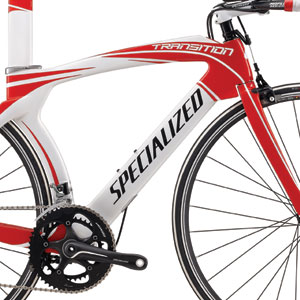
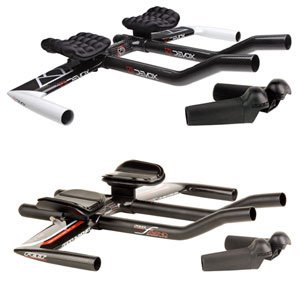
Start the discussion at slowtwitch.northend.network